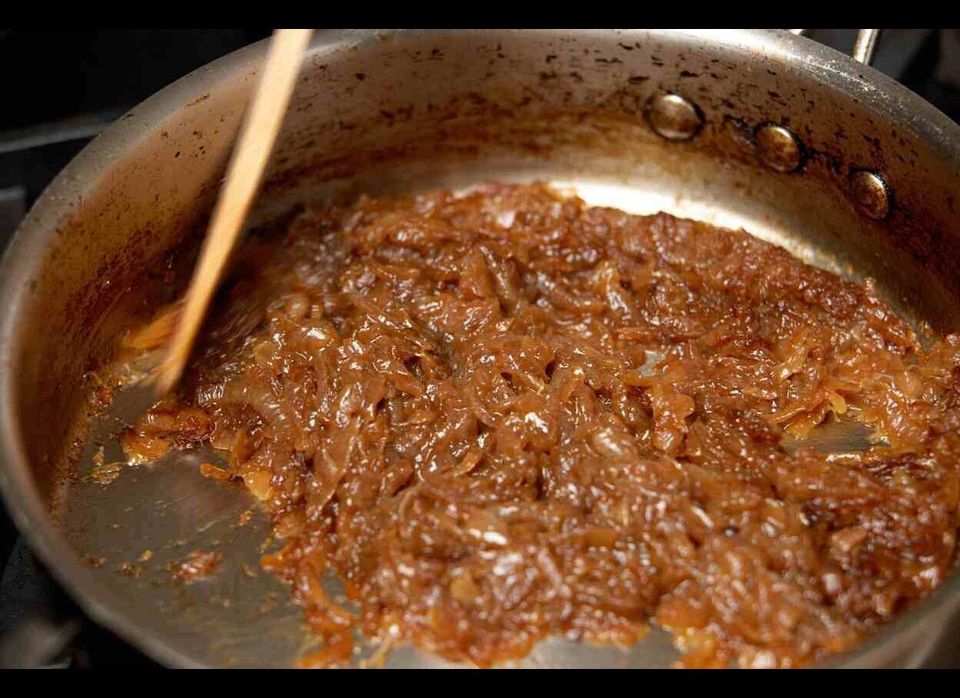It's the first day of class. I'm so excited that I've barely slept all night. I stop at reception and the girl politely hands me my regulation dress uniform, fully equipped with chef's jacket, toque or cloth hat and neckerchief. (Note to self: Not sexy but definitely a little bit Bad Ass.) Although I'm told the tradition dates back to the mid-19th century, this uniform is clearly in need of a "Project Runway" makeover.
I quickly realize I don't have my regulation plain black leather shoes and lose points with Chef Ray Dawson as I shuffle in behind the other new students. Overall, I'm excited and can't wait to get started. I'm incredibly impressed with the overall set-up. We are immediately treated as if we are professional students in the culinary arts career program, a six-month intensive. As we all chant "Yes, Chef" in unison, I begin to realize this isn't just another "cooking class". I'm given a shiny new set of tools and knives as well as a bible of culinary techniques to study. Suddenly, at age forty, I feel like a kid on Christmas morning.
Chef Ray is immediately inspiring. He makes me want to be not only a better chef, but also a better person. His passion for food is infectious and the room is filled with excitement. Each student has a story, a reason for taking 110 intensive hours of culinary boot camp. He reviews the safety regulations of the kitchen and we begin our first demonstration of knife skills. It doesn't take me long to realize I don't have any.
By afternoon, I have cut four out of five fingers. As I draw the last bit of blood, I hide my hand under my apron, applying maximum pressure to prevent further embarrassment and blood loss. I'm now officially cursing my parents for a lack of superior genetic material. I quickly earn the affectionate nickname "hot mess" from my partner, Daniel, who is currently on sabbatical from a successful career in the world of finance.
After class, I hobble over to the shoe store and purchase the unfashionable but ridiculously comfortable chef clogs. I then make my way to the subway toting more knives than a serial killer.
The first few days we focus on Tournage, the technique of shaping and carving. The word "tournage" comes from the French verb tourner, which means simply "to turn." The idea is to cut each vegetable into faceted-oval shapes-usually with seven sides and blunt ends. The end result is beautiful and worth all of the time, effort and practice. We cook our first batch of vegetables à l'anglaise, a technique used for cooking vegetables prior to service, where they are plunged into an ice bath for reheating later. The second batch is cooked à l'etuvée. This is a simple method to cook vegetables to perfection using a little water, a pinch of salt, butter and a parchment lid cut to size to control the rate of the evaporation.
By the seventh day I hit my stride and we are cooking my favorite dish, French Onion Soup. The kitchen has become a zen-like sanctuary where the rhythmic chopping, pounding, seasoning and stirring starts to work it's healing magic on my soul. The sites and sounds are intoxicating. The class has bonded in a "Breakfast Club," ragtag sort of way and I'm happy.
More importantly, for the first time in a long time I'm inspired.
Recipe taken from International Culinary Center, Culinary Techniques
French Onion Soup
GRATINÉE À L'OIGNON
2 ½ oz Butter
1 lb, 5 oz. onions, èmincer (thinly slice)
Salt and freshly ground black pepper, to taste
1 (T) all-purpose flour
1 garlic clove, chopped
3 ¼ oz dry sherry
1 quart chicken stock, beef stock or combination of each
¼ baguette
7 oz Emmenthaler cheese, Gruyère cheese, or mixture of both
1.Heat the butter in a soup pot or a rondeau. When hot, add the onions and cook over medium heat for 20 to 30 minutes.
2.When the onions are soft, increase the heat and continue to cook them for 5 to 10 minutes more, or until caramelized. Season lightly with salt and singer, (which means to sprinkle with flour before sautéing or placing in the oven).
3.Add the garlic and cook for 2 minutes. Then add the sherry and reduce by half. In the meantime, bring the stock to a simmer.
4.Add the hot stock, bring to a simmer, and cook at a low simmer for 20 minutes. Season to taste and serve hot.
5.Cut the baguette into 1-cm slices. Place on a sheet pan and brown in a 375° F oven for six to eight minutes or until nicely colored.
6.Grate the cheese and set aside.
7.Place 2 to 3 bread slices in the bottom of each bowl. Pour over the hot soup, filling the bowl to the rim. Sprinkle approximately 2 ounces of cheese on top, making sure to cover the bread and touch the edges of the bowl so it will adhere to the sides when melted.
8.Set the bowls on a half-sheet pan and place in the oven until the cheese melts, 5 to 10 minutes. Run the bowl under the broiler to brown the top. Serve the soup immediately while hot and puffy.
PHOTOS: French Onion Soup
Tune in next week for the recipe to make the stock.
Heidi Brod along with her partner, Lisa Stolov have a daily newsletter/website DishInOutBeauty.com that focuses on health and beauty from the inside out.
